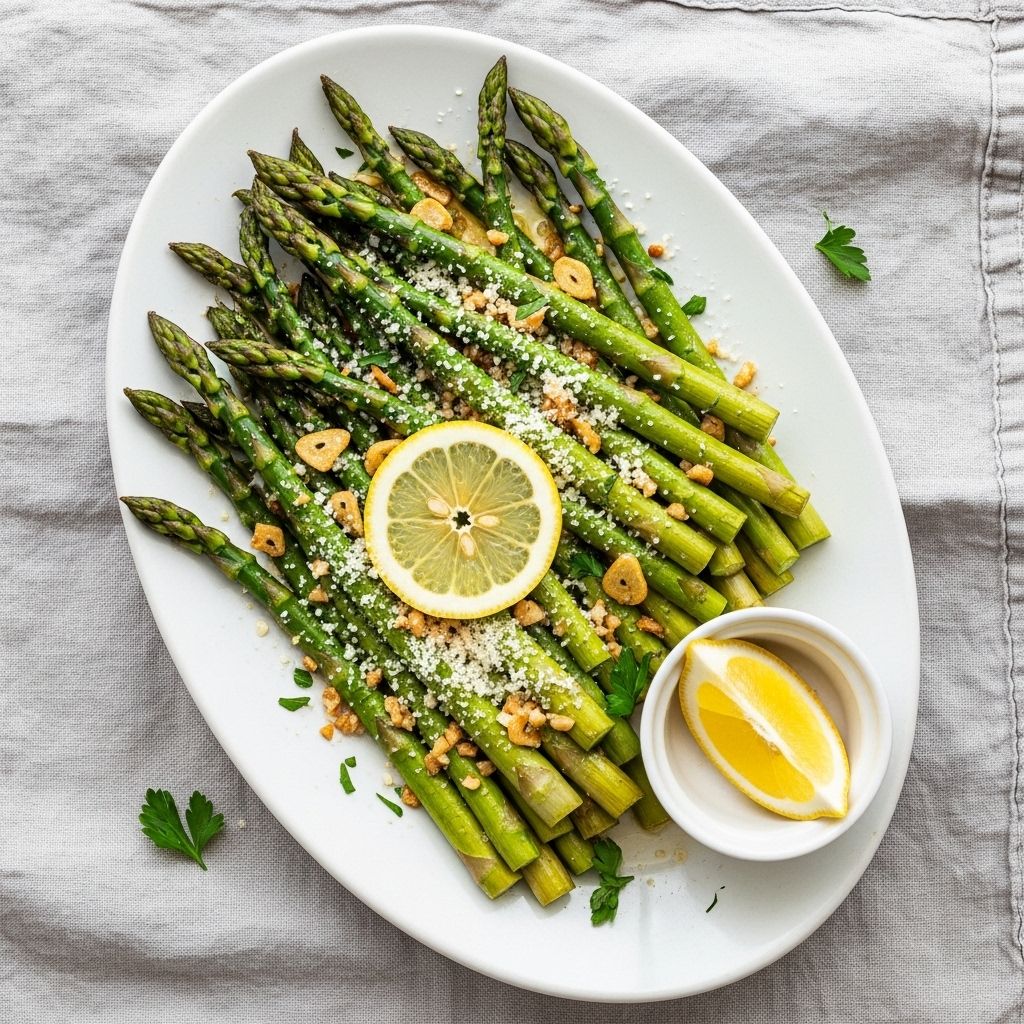Sautéed Asparagus: A Simple yet Elegant Side Dish
A simple twist on spring vegetables that brings bright flavor to every dinner.

Introduction to Sautéed Asparagus
Sautéed asparagus is a quick and versatile vegetable side dish that pairs well with almost any meal. Whether you’re preparing a fancy steak dinner or a weeknight meal, this recipe is both impressive and easy to execute. The addition of garlic, lemon, and parmesan cheese elevates the natural sweetness of the asparagus, making it a delightful accompaniment to your favorite dishes.
How to Store Asparagus
When you purchase asparagus, you might notice it is often displayed in a shallow bin of water at the grocery store. This is because asparagus stays fresher when its cut ends are submerged in water. To replicate this at home, simply trim the ends of the asparagus and place them in about 1 inch of water. If you’re not cooking the asparagus immediately, it’s best to store it in the refrigerator, loosely covered with a plastic bag or plastic wrap. For optimal freshness, use asparagus within three days of bringing it home.
Thin vs. Thick Asparagus: Choosing the Right Type
The choice between thin and thick asparagus largely depends on your cooking method. Both types of asparagus taste similar, but thick asparagus is better suited for grilling because it can withstand high heat. Thin asparagus, on the other hand, is more delicate and might shrivel on the grill, so it’s best used in recipes where it’s cooked more gently, such as sautéing or roasting.
Sautéed Asparagus Recipe
This recipe is a simple yet elegant way to prepare asparagus. It includes ingredients like garlic, lemon, olive oil, and parmesan cheese, which enhance the natural flavor of the asparagus.
Ingredients:
–
1 bunch of asparagus
(about 1 1/4 lb.)–
1 Tbsp. olive oil
–
1 Tbsp. unsalted butter
–
2 cloves garlic, chopped
–
1 tsp. salt
–
1/2 tsp. ground black pepper
–
1/2 lemon
–
2 Tbsp. grated parmesan cheese
, for serving Directions:
1.
Trim the Asparagus
: Cut off the woody ends from the base of the asparagus spears by cutting off the bottom 2 inches or by snapping it off with your hands.2.
Heat the Skillet
: Heat a large skillet over medium-high heat. Add the oil and swirl to coat the pan. Place the asparagus in a single layer and cook, turning occasionally, until lightly golden and almost tender, 8 to 10 minutes. (Cut a small piece from the end of one asparagus to check if it’s near tender.)3.
Finish with Butter and Garlic
: Reduce the heat to low. Add the butter, garlic, salt, and pepper, and stir to coat the asparagus. Cook until the garlic is softened and fragrant, 1 to 2 minutes more. Immediately transfer to a serving plate.4.
Serve
: Just before serving, squeeze the juice from the lemon half over the asparagus and sprinkle with parmesan cheese. Serve immediately.Tips for Cooking Asparagus
–
Adjust Cooking Time Based on Thickness
: For super-thin asparagus, cook about two minutes less than recommended. For very thick asparagus, cook about two minutes more.–
Use Fresh Asparagus
: Fresh asparagus is essential for the best flavor and texture. If you’re using frozen or canned asparagus, you might need to adjust the cooking time and method accordingly.Other Ways to Cook Asparagus
Beyond sautéing, asparagus can be prepared in several other delicious ways:
Other Cooking Methods:
–
Grilled Asparagus
: Perfect for thicker asparagus, grilling adds a smoky flavor.–
Roasted Asparagus
: Quickly roasting in the oven brings out a rich, caramelized flavor.–
Steamed Asparagus
: A healthier option, steaming preserves nutrients and natural taste.Frequently Asked Questions (FAQs)
Q: How long does asparagus last in the refrigerator?
A: Asparagus is best consumed within three days of bringing it home. It should be stored in the refrigerator with the cut ends submerged in water, loosely covered with a plastic bag or wrap.
Q: Is it better to use thin or thick asparagus?
A: Both thin and thick asparagus can be delicious, but the choice depends on the cooking method. Thick asparagus is ideal for grilling, while thin asparagus is better suited for sautéing or roasting to prevent it from becoming too dry.
Q: Can I use frozen asparagus for sautéing?
A: While frozen asparagus can be used, fresh asparagus provides the best flavor and texture. If using frozen, thaw it first and pat dry before sautéing.
Summary
Sautéed asparagus is a versatile and flavorful side dish that can enhance any meal. Whether you choose thin or thick asparagus, the key is to cook it gently to preserve its tender texture. With the addition of garlic, lemon, and parmesan cheese, this dish is sure to delight both family and friends.
References
- https://www.thepioneerwoman.com/food-cooking/recipes/a38985039/sauteed-asparagus-recipe/
- https://www.thepioneerwoman.com/food-cooking/recipes/a35701355/lemon-roasted-asparagus-recipe/
- https://www.youtube.com/watch?v=VmHCXZxnWhg
- https://www.thepioneerwoman.com/food-cooking/meals-menus/g42861285/asparagus-recipes/
Read full bio of medha deb












